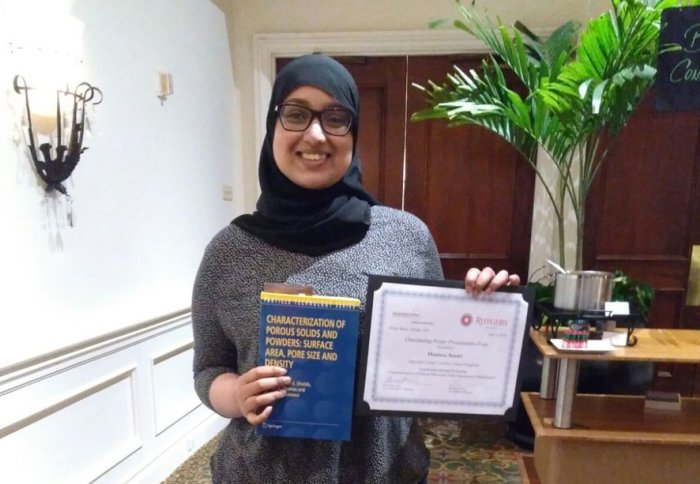
Humera Ansari wins Outstanding Poster at CPM-8 conference

PhD student Humera Ansari wins first prize for her poster at the Characterization of Porous Materials 8th International Conference.
Humera’s poster showcased her research into CO2 enhanced shale gas recovery, where she is investigating the physical process of adsorption and the use of shale reservoirs in carbon capture storage (CCS). Organised by Quantachrome, the international conference featured 91 poster presentations on a wide range of micro- and mesoporous materials, characterisation techniques, and theoretical and computational methods related to the characterisation of porous materials. The conference was held earlier this month at Delray Beach in Florida, USA.
As a relatively new area of research, Humera is one of a handful of scientists in the world experimentally testing ways to improve the production rates of underground shale reservoirs by implementing carbon capture storage (CSS) methods in the process.
“It’s great to be recognised by people you look up to in the community, as it places value on the research that you do. I’d like to thank my supervisors for their support and Quantachrome for organising the conference.” Humera Ansari, PhD student
Hydraulic fracturing, otherwise known as fracking, extracts methane from underground shale reservoirs by introducing and widening the existing fractures in shale which enables the gas to escape. However, this process leads to poor extraction efficiencies. To improve cost efficiency, researchers have been investigating whether combining fracking with injection of waste CO2 into depleted reservoirs will offset these costs.
Humera’s work takes this research one step further by experimenting with how much more efficient the process could be if carbon dioxide was injected into reservoirs during the fracking process. Research suggests that more methane can be released if carbon dioxide is injected first, but the theory requires further evidence before it can be implemented by industry.
Little is understood about adsorption in these reservoirs; how long it takes CO2 to reach the underground reservoirs, how the rock's composition affects adsorption, and how long carbon dioxide can be stored in this way without the risk of it leaking back into the atmosphere. By measuring adsorption on different shales to better understand their porosity, Humera is aiming to provide solutions to some of these challenges.
To find out more about Carbon Capture Storage (CCS) visit the Qatar Carbonate and Carbon Storage Research Centre page.
Article text (excluding photos or graphics) © Imperial College London.
Photos and graphics subject to third party copyright used with permission or © Imperial College London.
Reporter

Sara West
Communications Division

Contact details
Tel: +44 (0)20 7594 6607
Email: sara.west@imperial.ac.uk
Show all stories by this author


